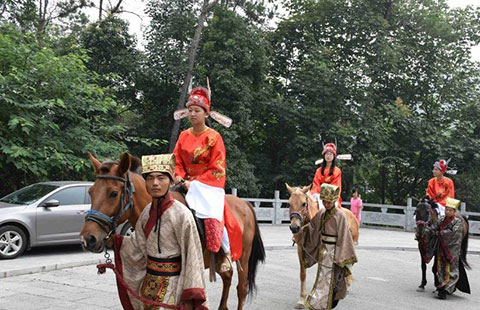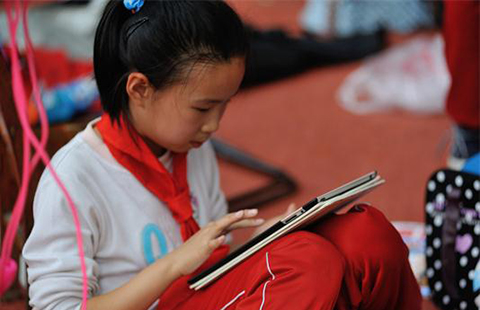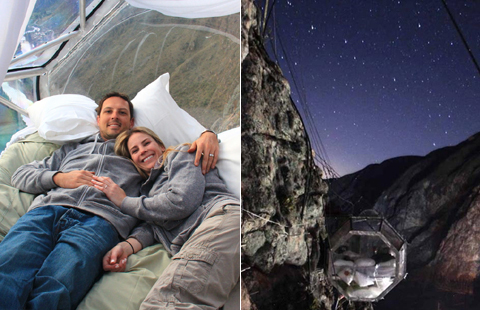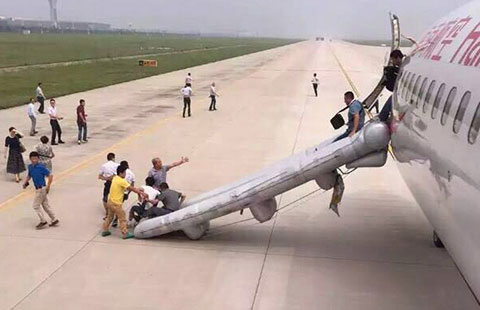Making tracks
Updated: 2015-07-13 07:23
By Yang Feiyue, Erik Nilsson and Su Zhou(China Daily)
|
||||||||
Authorities have announced new tourism-train routes for summer sojourners. Yang Feiyue, Erik Nilsson and Su Zhou report.
All aboard for summer fun!
Summertime is the time to hit not only the road but also the tracks, as China's travel chugs into peak season with special tourist-train trips.
Rail authorities recently announced four scenic tours on three routes starting from Beijing in July and August. They head to the cooler Northeast and Northwest with stops at scenic sites, as well as to Hebei province's 2022 Winter Olympics bidder, Zhangjiakou.
Officials also announced the operation of the "most beautiful high-speed rail" route from Anhui's provincial capital, Hefei, to Fujian's provincial capital, Fuzhou.
"Trains are better than planes in connecting scenic spots," says Wang Jianguo, sales manager with the Beijing-based China Railway Travel Service, the summer trips' organizer. The agency is affiliated with the Beijing Railway Bureau.
The travel agency has offered special summertime rail tours for over a decade to accommodate demand, especially from families, during the hottest season.
He says the company has received about 80 daily calls from interested travelers since the announcement. The company's June 12 rail tour of northeastern China was fully booked.
Tourist trains stop at stations close to attractions, allowing passengers to visit sites, then hop back on board.
For instance, the Northwest route's train will stop for a full day and night so passengers can visit Qinghai Lake and other sites, Wang says.
The ticket price also includes a hotel room and meal, so guests can shower. (Food on board costs extra.)
Most travel will be done at night so travelers can spend more daylight hours at attractions. Yet much can be seen through the windows, so the experience is about the journeys as well as the destinations.
Northeast route
The 11-day Northeast tour departs on July 26 and will stop at the Inner Mongolia autonomous region's Hulun Buir and Manzhouli; Helongjiang province's Daqing and Qiqihar; and Jilin province's Changbai Mountains and Tianchi Lake, from where you can peek across the border into the Democratic People's Republic of Korea.
A ticket costs 4,580 yuan ($739) for an adult and 1,580 yuan for a child.
"Northeast China's cool weather makes it an ideal summer getaway," Wang says.
Northeast-route passengers will see reed marshes and red-crowned cranes in Qiqihar's Zhalong National Nature Reserve, view vast prairies in Hulun Buir and experience border-town life in Manzhouli, which bounces off Russia. Heilongjiang's highlights include the landmark Flood Control Monument, Stalin Park and the Songhua River.
Northwest route
The Northwest route threads through Inner Mongolia's grasslands and stops at attractions in the Ningxia Hui autonomous region, and Gansu and Qinghai provinces. The trip starts on July 17 and lasts seven days. Its sequel, starting on Aug 8, lasts eight.
Tickets cost 4,280-4,580 yuan ($689-737), depending on the bunks and travelers' ages. (People above 70 get a discount.)
The Northwest route is conceived in accord with the Belt and Road Initiative's goal of developing western China's tourism, Wang says.
Passengers can view landscapes with deserts, rivers, mountains and oases in one vista at Shapotou in Ningxia's Zhongwei city.
They can experience Mongolian culture on grasslands bristling out from the Tengger Desert between Inner Mongolia and Ningxia.
Passengers also visit Gansu's largest Tibetan Buddhist temple, Labrang Monastery; Nuoergai and Ganan grasslands; and the Great Wall's westernmost terminus, the Jiayuguan Pass.
"Seeing the vast Gobi Desert after we passed the Jiayuguan Pass was breathtaking," says Wei Hongtao, who took his parents on a rail tour from Beijing to the Xinjiang Uygur autonomous region on June 19.
Zhangjiakou route
The tour from Beijing to Hebei province's Zhangjiakou rides the wave generated by the city's application to co-host the 2022 Winter Olympics. It's scheduled for Aug 16 and will last three days.
The Zhangbei grassland will be one of the highlights, Wang explains.
'Most beautiful high-speed rail'
The Hefei-Fujian high-speed railway runs through Anhui, Jiangxi and Fujian provinces. It stops at such spots as the pine-fleeced Huangshan Mountains, the ancient county of Wuyuan and the karst Wuyi Mountains, known for tea production.
It's not only reportedly among the most picturesque railways to ride but also the trickiest to construct since it's China's first bullet train to zoom through mountain ranges. More than 85 percent of the track runs on bridges or through tunnels, China Radio International reports.
Online travel service provider Ctrip says bookings have grown rapidly since the line opened. The company predicts it'll rank among the most popular summer routes.
"Since July, the number of tourists visiting Wuyi and Xiamen (scenic spots in Fujian accessible by the railway) more than doubled compared with last year," Ctrip publicity officer Yan Xin says.
"(So), we've introduced 52 travel routes for group and individual travelers."
Cheap and easy
"High-speed rails are more convenient and cheaper than flights and regular trains attract people who didn't think about travel before," Yan says.
"Groups using high-speed rails rather than flights save about 30 percent."
Tourism authorities and scenic spots along routes have introduced discounts, Yan says.
Transportation constrained tourism in the past, China Tourism Leisure Association secretary-general Wei Xiao'an says.
"In the '80s, we had fewer trains. The number of tickets available decided the number of tourists," Wei says.
China has built more than 16,000 kilometers of high-speed track since its first bullet train shot out of the station in 2008. About 10,000 km more are under construction.
Nearly 80 percent of respondents to a recent survey by Chinese online travel agency Tuniu.com report plans to travel by train.
"Shortened travel hours mean visitors don't stay as long," Wei says.
"This means local service providers need to improve their products to not only attract but also keep guests."
Contact the writers through yangfeiyue@chinadaily.com.cn
(China Daily 07/13/2015 page22)

 Top gaokao scholars saddle up for a ride in the park
Top gaokao scholars saddle up for a ride in the park
 Girl who shoots straight with bow and arrow
Girl who shoots straight with bow and arrow
 Ten photos you don't wanna miss - July 10
Ten photos you don't wanna miss - July 10
 Forum Trends: Should we pay children to study?
Forum Trends: Should we pay children to study?
 Bereaved seniors turn attention to grandchildren
Bereaved seniors turn attention to grandchildren
 Unusual but true: sleep in a transparent glass room clinging to cliff
Unusual but true: sleep in a transparent glass room clinging to cliff
 24-year-old ethnic Chinese girl runs for US Congress
24-year-old ethnic Chinese girl runs for US Congress
 Plane makes emergency landing after fire
Plane makes emergency landing after fire
Most Viewed
Editor's Picks

|

|

|

|

|

|
Today's Top News
Leaders agree on partnership blueprint
New Development Bank launched in Ufa
IMF keeps 6.8% China growth view
Leaders agree on partnership blueprint
More tariffs on Chinese solar panels
Students study depression to raise suicide awareness
Official denial raises doubts over '40-year-old meat' story
Yuan hit by turmoil in the market
US Weekly

|

|






